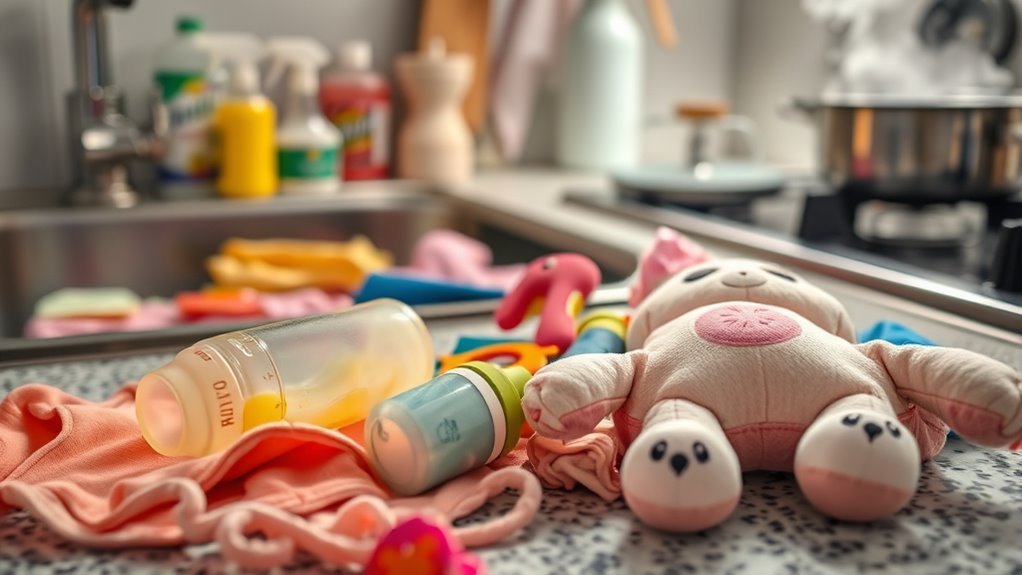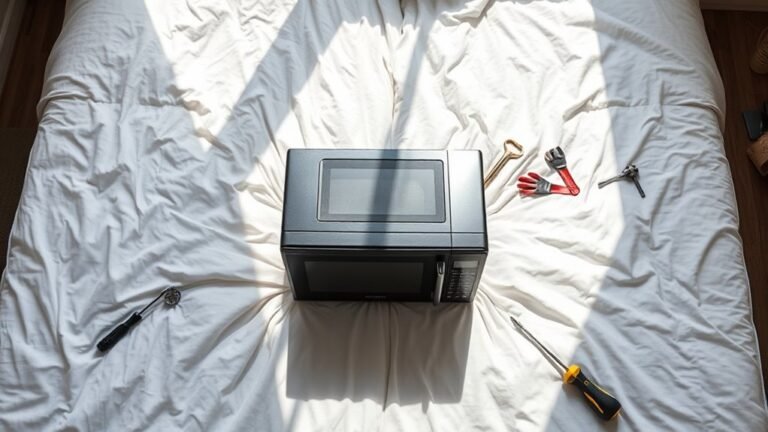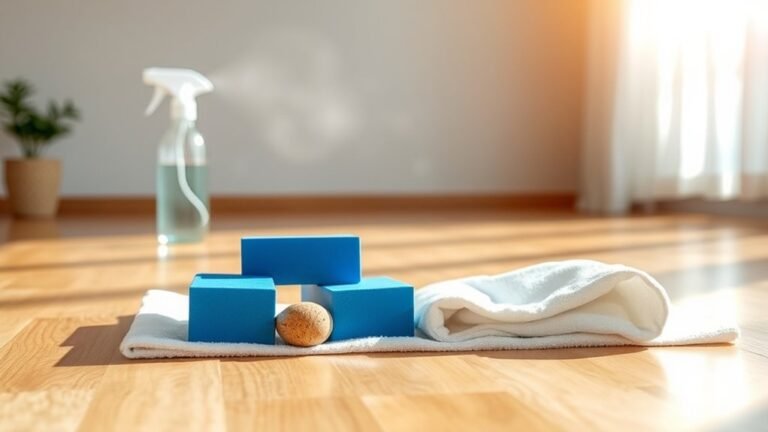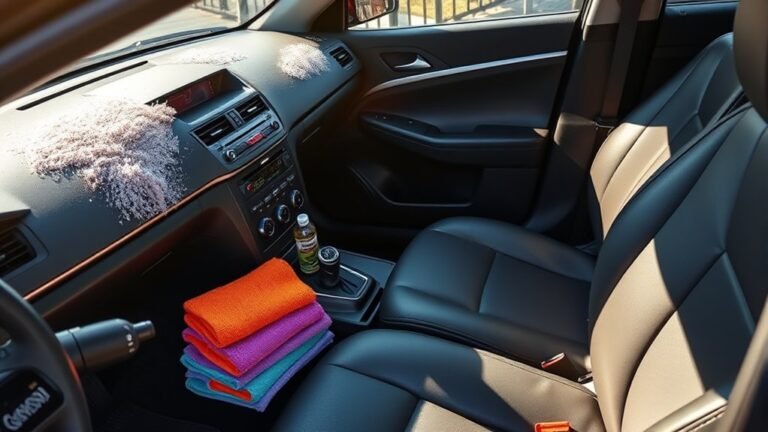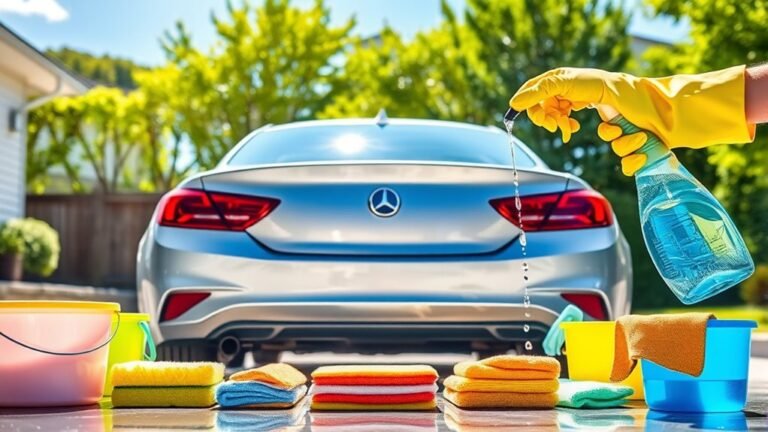Common Mistakes When Cleaning Baby Items
When cleaning your baby’s items, avoid harsh chemicals that can irritate sensitive skin, and always wash your hands first to stop spreading germs. Don’t skip regular deep cleaning or thorough washing of bottle nipples, as hidden residue can cause bacteria buildup. Check if items are dishwasher-safe before tossing them in, and rinse with filtered water instead of untreated tap water. Also, store cleaned items in sanitary places and replace worn products promptly. Keep these tips in mind, and you’ll find even more ways to keep your baby’s essentials safe and clean.
Using Harsh Chemicals on Baby Items

While it might seem like a quick way to disinfect, using harsh chemicals on baby items can actually do more harm than good. You want your little one’s environment to be safe and free from toxins, not filled with residues that could irritate their sensitive skin or respiratory system. Instead, focus on safe cleaning practices that protect both your baby and your peace of mind. Organic alternatives offer a liberating way to keep things clean without the risk of harmful chemicals. These options harness natural ingredients, giving you freedom from worrying about long-term effects. By choosing gentle, non-toxic cleaners, you’re not just cleaning—you’re creating a safer space where your baby can explore and grow with confidence.
Not Washing Hands Before Cleaning
Even if you’re thorough with cleaning baby items, skipping handwashing beforehand can undo all your efforts. When you don’t practice proper hand hygiene, you risk transferring germs and dirt back onto the very things you’re trying to clean. It’s easy to think your hands are clean, but invisible bacteria can hitch a ride, undermining germ prevention. Taking a moment to wash your hands with soap and water before cleaning baby bottles, toys, or pacifiers is a simple yet powerful step. It keeps the environment safer for your little one and gives you peace of mind. Don’t let a quick hand wash feel like a chore—think of it as your first line of defense in keeping baby items truly clean and germ-free.
Skipping Regular Deep Cleaning

Washing your hands before cleaning baby items helps prevent germs from spreading, but that’s just one part of the process. If you skip regular deep cleaning, you might miss hidden buildup that everyday wipes don’t tackle. Setting a clear cleaning schedule guarantees you stay on top of deep cleaning frequency, keeping bottles, toys, and pacifiers truly sanitized. Deep cleaning isn’t about scrubbing daily; it’s about committing to thorough care at regular intervals to prevent bacteria and grime from accumulating. By sticking to a routine, you free yourself from constant worry and create a safer environment for your baby. Remember, consistent deep cleaning is key to maintaining both cleanliness and your peace of mind. Don’t let shortcuts derail your baby’s health.
Using Dishwashers Without Checking Manufacturer Guidelines
Before you toss baby bottles and toys into the dishwasher, make certain you check the manufacturer’s guidelines. Ignoring these instructions can lead to damaged items or ineffective cleaning. Not all baby products are dishwasher-safe; some materials may warp or degrade under high heat. Following manufacturer instructions guarantees you maintain dishwasher safety and protect your baby’s items. It also assures the cleaning process doesn’t compromise the product’s integrity or safety. Taking a moment to review these guidelines gives you the freedom to clean confidently without risking costly replacements or exposing your baby to harmful residues. Remember, dishwasher safety isn’t universal—stick to the rules from the makers, and you’ll keep your baby’s essentials clean and safe every time.
Neglecting to Clean Bottle Nipples Thoroughly

You might not realize that milk residue can hide in the tiny crevices of bottle nipples, making them harder to clean properly. If you don’t dry them thoroughly, moisture can encourage bacteria growth. Paying close attention to these details helps keep your baby’s feeding items safe and hygienic.
Hidden Milk Residue
Although it might seem like rinsing bottle nipples quickly is enough, hidden milk residue can easily remain trapped in the tiny crevices. Milk residue causes bacteria to build up, which can lead to unpleasant odors and potential health risks for your baby. Identifying hidden residue isn’t always straightforward since it’s often invisible to the naked eye. To avoid this, you’ll want to take your time cleaning every nook and cranny with a dedicated nipple brush and warm, soapy water. Don’t skip soaking nipples regularly to loosen stubborn milk deposits. By thoroughly cleaning and inspecting bottle nipples, you’ll guarantee your baby’s feeding gear stays fresh and safe. Taking these simple steps gives you the freedom to trust your routine without worrying about unseen buildup.
Improper Drying Methods
One common mistake is leaving bottle nipples damp or covering them before they’re fully dry. When you do this, moisture gets trapped, creating a breeding ground for bacteria and mold. To avoid this, embrace proper air drying techniques. After washing, place nipples on a clean drying rack where air can circulate freely around them. This lets them dry completely without risk. Also, be mindful of drying equipment safety—ensure your racks and cloths are sanitized regularly to prevent contamination. Avoid using towels that might leave lint or harbor germs. By letting nipples dry thoroughly and safely, you’re protecting your baby’s health and giving yourself the freedom from constant re-cleaning. It’s a small step that makes a big difference in keeping baby items hygienic and safe.
Overlooking Cleaning of Soft Toys and Fabric Items
While many parents focus on cleaning bottles and toys, soft toys and fabric items often get overlooked. These items can harbor germs and allergens, so soft toy sanitization and fabric item care are crucial. Don’t just assume a quick surface wipe is enough; regular washing keeps your baby’s environment safe and fresh.
| Item Type | Cleaning Frequency | Recommended Method | Notes |
|---|---|---|---|
| Soft Toys | Weekly | Machine wash or disinfect | Check label for water safety |
| Fabric Blankets | Weekly or as needed | Gentle cycle, mild detergent | Avoid harsh chemicals |
| Plush Animals | Biweekly | Hand wash or machine wash | Confirm thorough drying |
| Fabric Covers | Weekly | Machine wash | Replace if heavily stained |
Using Dish Soap That Leaves Residue
If you’re not careful with the dish soap you use to clean baby items, residue can be left behind that might irritate your little one’s sensitive skin. Many conventional soaps contain chemicals that don’t rinse off completely, causing discomfort or allergic reactions. To avoid this, consider dish soap alternatives designed specifically for baby items—they’re gentle, effective, and rinse clean without leaving harmful residues. Always rinse thoroughly under running water to guarantee no soap remains. Residue prevention is key to keeping your baby safe and comfortable. By choosing the right cleaning agents and rinsing carefully, you free yourself from worry and let your child enjoy their toys and bottles without irritation. Remember, a clean baby item is only truly clean when free of leftover soap.
Storing Clean Baby Items in Unsanitary Places
Even after cleaning, storing baby items in damp or dusty places can lead to contamination. You should keep them in dry, clean areas and use sealed containers to protect them. This simple step helps keep your baby’s items safe and hygienic.
Avoid Damp Storage Areas
Because moisture encourages mold and bacteria growth, you shouldn’t store clean baby items in damp areas. To maintain proper mold prevention and moisture control, follow these steps:
- Choose storage spots with good air circulation to help items dry completely and avoid moisture buildup.
- Use airtight containers or sealed bags to protect baby items from humidity and airborne contaminants.
- Regularly check and air out storage spaces to prevent hidden dampness that can encourage mold growth.
Keep Away From Dust
After making sure your baby items are stored in dry, well-ventilated areas, you’ll also want to keep them away from dust and dirt. Even the cleanest items can quickly become contaminated if left in places where dust settles easily. To maintain a dust free environment, avoid storing baby essentials on open shelves or near windows where airborne particles blow in. Instead, choose spots that naturally limit dust buildup, helping you maintain cleanliness without extra effort. Remember, keeping baby items in unsanitary spaces defeats the purpose of your cleaning routine. By being mindful of where you store these items, you protect your little one’s health and enjoy the freedom of knowing their belongings stay truly clean and ready for use whenever needed.
Use Clean, Sealed Containers
While storing baby items properly is essential, using clean, sealed containers makes a significant difference in keeping them sanitary. If you want to avoid contamination, consider these key points:
- Choose container materials that are non-toxic and easy to clean, like BPA-free plastic or glass, to guarantee safety and durability.
- Apply effective sealing techniques—airtight lids or vacuum seals prevent dust, moisture, and germs from sneaking in.
- Regularly inspect and clean both containers and seals to maintain a germ-free environment for your baby’s items.
Not Replacing Worn or Damaged Items Promptly
If you don’t replace worn or damaged baby items promptly, you risk exposing your little one to germs, choking hazards, or ineffective protection. Knowing the baby item lifespan helps you schedule timely replacements and keep your baby’s environment safe and fresh. Don’t hold on to damaged bottles, pacifiers, or toys—freedom comes with keeping your baby’s essentials reliable.
| Item Type | Typical Lifespan |
|---|---|
| Bottles | 3-6 months |
| Pacifiers | 1-2 months |
| Toys | Varies; replace if damaged |
| Teething Rings | 1-2 months |
Replacing on time guarantees your baby’s health freedom and peace of mind. Stay proactive, and don’t let worn items hold you back.
Rinsing Items With Untreated Tap Water
Keeping baby items in good condition means more than just timely replacements; how you clean and rinse them matters too. Rinsing with untreated tap water can expose your little one to harmful bacteria or chemicals, especially if the tap water quality is questionable. To protect your child while maintaining freedom in your cleaning routine, consider these steps:
- Test your tap water quality regularly to know if it requires treatment.
- Use disinfecting techniques like boiling water or using a baby-safe sanitizer after washing items.
- Opt for filtered or bottled water when rinsing if your tap water is untreated or contains contaminants.
Frequently Asked Questions
How Often Should I Sterilize Baby Bottles?
Oh, sure, you could sterilize baby bottles every five minutes if you want, but that’s not exactly practical. For bottle sterilization frequency, once a day is usually enough if you’re using safe cleaning methods like thorough washing with hot soapy water. If your baby’s immune system is strong or the bottles aren’t used daily, you can ease up. Remember, freedom means not stressing over constant sterilization but keeping things clean and safe.
Can I Use Vinegar to Clean Baby Toys?
You can use vinegar to clean baby toys, and it’s a great natural option. Vinegar benefits include its ability to kill bacteria without harsh chemicals, making it safer for your little one. Just mix equal parts water and white vinegar in a spray bottle, wipe the toys, and rinse well. This way, you keep toy safety high while avoiding toxins. It’s simple, effective, and gives you freedom from worrying about harmful residues.
Is Boiling Water Safe for Cleaning Pacifiers?
Oh sure, why not toss your pacifier into boiling lava while you’re at it? Seriously though, boiling water is a popular sterilization method because it’s effective and chemical-free. Just make sure your pacifier materials can handle the heat—silicone usually does fine, but latex might warp or weaken. So, if you want to keep things safe and simple, boiling works, but always check the manufacturer’s guidelines before you liberate your pacifiers from germs.
How Do I Dry Baby Items to Prevent Mold?
To prevent mold on baby items, you’ll want to focus on proper drying techniques. After washing, shake off excess water and air-dry items completely in a well-ventilated area, preferably under sunlight if possible. Avoid storing damp items in closed containers, as moisture encourages mold growth. Using a clean, dry towel to gently pat items dry also helps speed up drying. These simple steps will keep your baby’s things fresh and mold-free, giving you peace of mind.
Are Natural Cleaning Products Safe for Baby Items?
You might wonder if natural cleaners are safe for baby items. Generally, they are a great choice because they avoid harsh chemicals, supporting baby safety. However, you’ve got to check that the product is truly non-toxic and rinse items thoroughly to remove residue. Choosing natural cleaners lets you keep your baby’s environment fresh and safe without sacrificing your freedom to use gentle, eco-friendly options.
